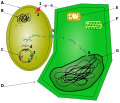Agrobacterium tumefaciens
Agrobacterium tumefaciens[edit]

Agrobacterium tumefaciens is a Gram-negative bacterium that is well known for its ability to transfer DNA to plants, causing crown gall disease. This bacterium is a member of the family Rhizobiaceae and is closely related to other plant-associated bacteria.
Biology[edit]
Agrobacterium tumefaciens is a rod-shaped, motile bacterium that is found in the soil. It is an aerobic organism that can utilize a variety of carbon sources. The bacterium is characterized by its ability to transfer a segment of its DNA, known as the T-DNA, into the genome of a host plant. This process is facilitated by the Ti plasmid, which carries the genes necessary for DNA transfer and integration.
Mechanism of DNA Transfer[edit]

The process of DNA transfer begins when Agrobacterium tumefaciens attaches to a wound site on a plant. The bacterium senses plant-derived signals, such as phenolic compounds, which activate the virulence genes on the Ti plasmid. These genes encode proteins that mediate the transfer of T-DNA into the plant cell. Once inside the plant cell, the T-DNA is integrated into the plant genome, leading to the expression of genes that cause the formation of a tumor-like growth known as a crown gall.
Applications in Biotechnology[edit]

Agrobacterium tumefaciens has been harnessed as a tool for genetic engineering in plants. By replacing the tumor-inducing genes on the T-DNA with genes of interest, scientists can introduce new traits into plants. This method is widely used in the development of genetically modified organisms (GMOs) and has applications in agriculture, such as the development of herbicide-resistant and pest-resistant crops.
Disease Cycle[edit]

The disease cycle of Agrobacterium tumefaciens begins with the bacterium's entry into a plant through a wound. Once inside, the bacterium transfers its T-DNA into the plant cells, leading to the formation of crown galls. These galls provide a niche for the bacteria to proliferate and spread to other plants. The cycle continues as the bacteria are released into the soil from decaying plant material, where they can infect new hosts.
Crown Gall Disease[edit]

Crown gall disease is characterized by the formation of large, tumor-like growths at the site of infection. These galls can disrupt the normal growth and development of the plant, leading to reduced vigor and yield. The disease affects a wide range of plant species, including many economically important crops such as grapevines, stone fruits, and ornamentals.
Related Pages[edit]
Gallery[edit]
-
Agrobacterium tumefaciens
-
Mechanism of DNA transfer
-
Transformation of plants
-
Disease cycle
-
Crown gall on sunflower
Agrobacterium_tumefaciens[edit]
-
Agrobacterium tumefaciens
-
Transfection by Agrobacterium
-
Transformation with Agrobacterium
-
A. tumefaciens disease cycle
-
Crown Gall of Sunflower
Ad. Transform your life with W8MD's Budget GLP-1 injections from $75


W8MD offers a medical weight loss program to lose weight in Philadelphia. Our physician-supervised medical weight loss provides:
- Weight loss injections in NYC (generic and brand names):
- Zepbound / Mounjaro, Wegovy / Ozempic, Saxenda
- Most insurances accepted or discounted self-pay rates. We will obtain insurance prior authorizations if needed.
- Generic GLP1 weight loss injections from $75 for the starting dose.
- Also offer prescription weight loss medications including Phentermine, Qsymia, Diethylpropion, Contrave etc.
NYC weight loss doctor appointmentsNYC weight loss doctor appointments
Start your NYC weight loss journey today at our NYC medical weight loss and Philadelphia medical weight loss clinics.
- Call 718-946-5500 to lose weight in NYC or for medical weight loss in Philadelphia 215-676-2334.
- Tags:NYC medical weight loss, Philadelphia lose weight Zepbound NYC, Budget GLP1 weight loss injections, Wegovy Philadelphia, Wegovy NYC, Philadelphia medical weight loss, Brookly weight loss and Wegovy NYC
|
WikiMD's Wellness Encyclopedia |
| Let Food Be Thy Medicine Medicine Thy Food - Hippocrates |
Medical Disclaimer: WikiMD is not a substitute for professional medical advice. The information on WikiMD is provided as an information resource only, may be incorrect, outdated or misleading, and is not to be used or relied on for any diagnostic or treatment purposes. Please consult your health care provider before making any healthcare decisions or for guidance about a specific medical condition. WikiMD expressly disclaims responsibility, and shall have no liability, for any damages, loss, injury, or liability whatsoever suffered as a result of your reliance on the information contained in this site. By visiting this site you agree to the foregoing terms and conditions, which may from time to time be changed or supplemented by WikiMD. If you do not agree to the foregoing terms and conditions, you should not enter or use this site. See full disclaimer.
Credits:Most images are courtesy of Wikimedia commons, and templates, categories Wikipedia, licensed under CC BY SA or similar.
Translate this page: - East Asian
中文,
日本,
한국어,
South Asian
हिन्दी,
தமிழ்,
తెలుగు,
Urdu,
ಕನ್ನಡ,
Southeast Asian
Indonesian,
Vietnamese,
Thai,
မြန်မာဘာသာ,
বাংলা
European
español,
Deutsch,
français,
Greek,
português do Brasil,
polski,
română,
русский,
Nederlands,
norsk,
svenska,
suomi,
Italian
Middle Eastern & African
عربى,
Turkish,
Persian,
Hebrew,
Afrikaans,
isiZulu,
Kiswahili,
Other
Bulgarian,
Hungarian,
Czech,
Swedish,
മലയാളം,
मराठी,
ਪੰਜਾਬੀ,
ગુજરાતી,
Portuguese,
Ukrainian




